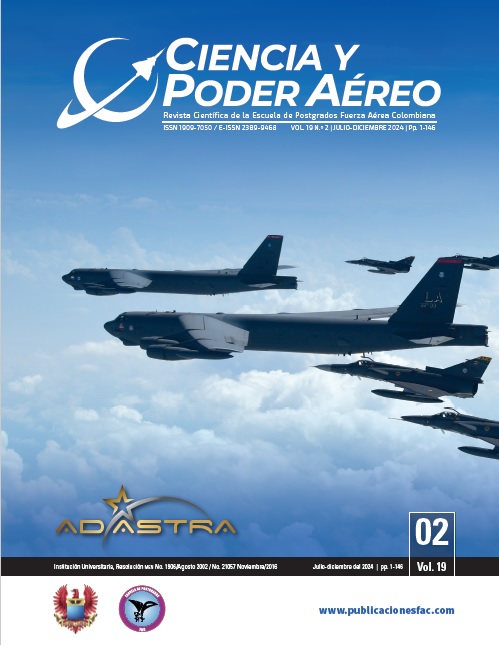Dynamic analysis of rounded projectiles
Software solution development
DOI:
https://doi.org/10.18667/cienciaypoderaereo.822Keywords:
Drag, kinematics, kinetics, lift, Magnus effect, mathematical modellingAbstract
The study of object motion has intrigued scholars for centuries, yet grasping the underlying physics and mathematics has remained a challenge. However, recent advancements in computational methods and the utilization of mathematical models from the 18th century have enabled a profound understanding of motion and accurate approximations of real-life object movements. By harnessing tools such as MATLAB and engineering analytical methods, we can create applications that simulate the motion of spherical projectiles. This provides valuable insights into real-world object motion and the associated forces and physics. Dynamic analysis, encompassing both kinematics and kinetics, allows for a detailed exploration of motion dynamics. Inspired by the concept of an ‘Olympic goal,’ (Clayfield, n. d.), our developed application allows users to visualize the impact of aerodynamic forces on objects. It demonstrates concepts like drag, lift, and the ‘Magnus effect,’ offering initial insights into object motion in fluid environments (Mody, 2015). This understanding acts as a foundation for modeling more intricate systems, including airplanes, rockets, and aerospace components. Notably, the application’s graphical representations of essential modeling elements provide a significant advantage. Furthermore, by emphasizing the motivations behind these phenomena, the application fosters curiosity and encourages users to delve deeper into these captivating events.
Downloads
References
Anderson, J. D. (2010). Fundamentals of Aerodynamics (5th ed.). McGrawHill.
Ang, D. G. (2013). Shape and Size Matter for Projectile Drag. The Journal of Advanced Undergraduate Physics Laboratory Investigations, 2. https://tinyurl.com/4k9uckwp
Blevins, R. D. (1985). Applied Fluid Dynamics Handbook. Van Nostrand Reinhold.
Cadence CFD Solutions (n. d.). The Relationship Between the Kinematic Viscosity of Air and Temperature. Cadence System Analysis. https://tinyurl.com/mtkpttn6
Cengel, Y. A. & Cimbala, J. M. (2010). Fluid Mechanics Fundamentals and Applications. McGrawHill.
Clayfield, B. (n. d.). How Fast is a Soccer Ball Kicked? [online]. https://tinyurl.com/3jm8mwmu
Cook, M. J. (2007). Flight Dynamics Principles: A Linear Systems Approach to Aircraft Stability and Control. Elsevier.
Dixit, U. S., Hazarika, M. & Davim, J. P. (2017). A Brief History of Mechanical Engineering (Materials Forming, Machining and Tribology). Springer.
Earth Data Open Access for Open Science. (n. d.). Air Mass/ Density. nasa. https://tinyurl.com/mph3fhb8
Goldstein, S. (1938). Modern Developments in Fluid Dynamics: An Account of Theory and Experiment Relating to Boundary Layers Turbulent Motion and Wakes. Oxford University Press
Kray, T., Franke, J. & Frank, W. (2014). Magnus Effect on a Rotating Soccer Ball at High Reynolds Numbers. Journal of Wind Engineering and Industrial Aerodynamics, 124, 46-53. https://doi.org/10.1016/j.jweia.2013.10.010
Meriam, J. L. & Kraige, L. G. (2012). Engineering Mechanics: Dynamics (7th ed.). John Wiley & Sons.
Meyers, R. A. (Ed.). (2001). Encyclopedia of Physical Science and Technology (3rd ed.). Academic Press.
Mody, V. (2015). High School Physics: Projectile Motion. CreateSpace Independent Publishing Platform.
Robinson, G. & Robinson, I. K. (2013). The Motion of an Arbitrarily Rotating Spherical Projectile and its Application to Ball Games. Physica Scripta, 88(1). https://doi.org/10.1088/0031-8949/88/01/018101
TheFA. (n. d.). Law 2: The Ball. ifab Laws of the Game 2023-24 [online]. https://tinyurl.com/4kut4smy
Said, A. A., Mshewa, M. M., Mwakipunda, G. C., Ngata, M. R. & Mohamed, E. A. (2023). Computational Solution to the Problems of Projectile Motion under Significant Linear Drag Effect. Open Journal of Applied Sciences, 13(4), 508- 528. https://doi.org/10.4236/ojapps.2023.134041
Sarafian, H. (2015). Impact of the Drag Force and the Magnus Effect on the Trajectory of a Baseball. World Journal of Mechanics, 5(4), 49-58. https://doi.org/10.4236/wjm.2015.54006
Published
Issue
Section
License
Copyright (c) 2024 Escuela de Postgrados de la Fuerza Aérea Colombiana

This work is licensed under a Creative Commons Attribution 4.0 International License.
Assignment of Copyrights
Authors assign Ciencia y Poder Aéreo journal the exclusive rights (reproduction, distribution, public communication, and transformation) to exploit and commercialize their work, in whole or in part, in all the formats and modalities of present or future exploitation, in all languages, throughout the life of the work and throughout the world.
All contents published in Ciencia y Poder Aéreo journal are licensed under a Creative Commons Attribution 4.0 International License, whose complete information is available at http://creativecommons.org/licenses/by/4.0/
Under the terms of this license, users are free to download, print, extract, archive, distribute and publicly communicate the content of articles, provided that proper credit is granted to authors and Ciencia y Poder Aéreo, scientific journal of the Graduate School of the Colombian Air Force. Except when otherwise indicated, this site and its contents are licensed under a Creative Commons Attribution 4.0 International License.
For other uses not considered under this license it is required to contact the Director or the Editor of the journal at the e-mail address cienciaypoderaereo1@gmail.com.
The Graduate School of the Colombian Air Force and this publication are not responsible for the concepts expressed in the articles, including the metadata or the affiliation stated by authors. This is the full responsibility of the authors.






















